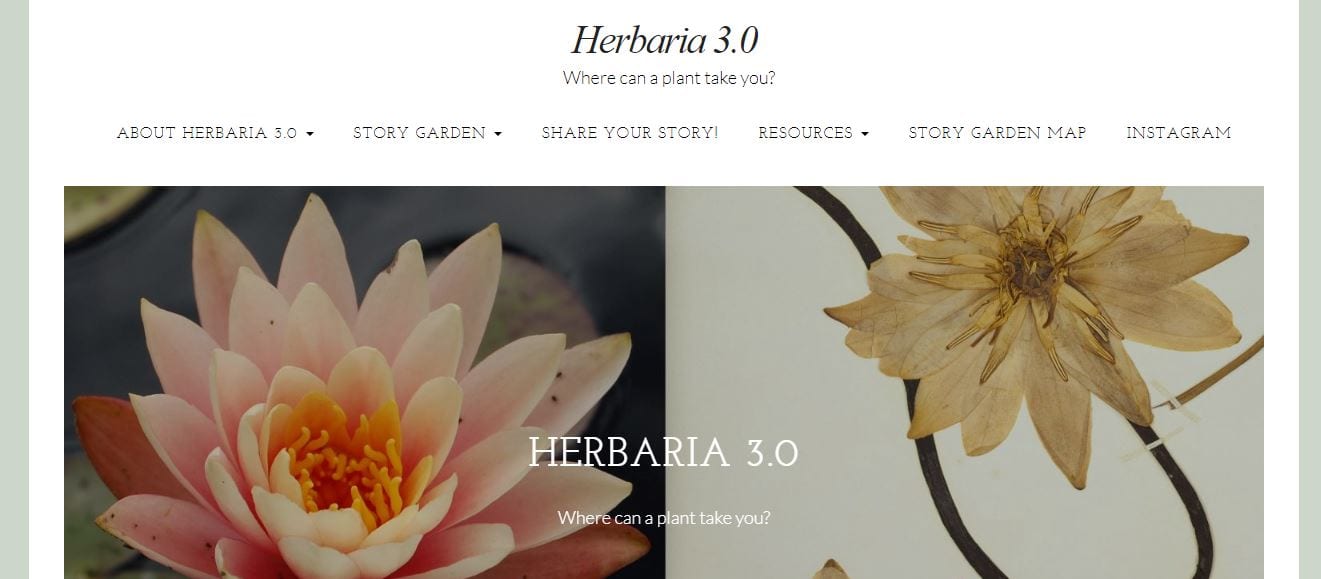ASLE members Tina Gianquitto and Lauren LaFauci, together with an interdisciplinary team consisting of two plant biologists and a pedagogy expert, recently launched Herbaria 3.0 (www.herbaria3.org), a collaborative digital humanities project. Herbaria 3.0 collects, shares, and archives stories about plants and people from all over the world.
The project began with a question posed by team member Dawn Sanders—“where can a plant take you?”—that in turn invited metaphorical, geographical, and material responses. A plant can motivate travel, trigger homesickness, create connection, and open new understandings. Accordingly, the site features a map that documents locations of the human storytellers, recognizing that such locations are not necessarily the sites of the plant’s “natural” (or historical) range or even the location of the story itself. Like herbaria sheets housed in locations far from their collection sites, the map often reveals large temporal and spatial gaps between plant, person, and story.
“Herbaria” also serve as the organizing metaphor for the project because these collections of plant specimens historically documented not merely the science of what plants were growing where but also the human cultural relationship with those plants. Herbaria are collections of dried plant specimens that originated in Renaissance Italy to document medicinal plants; these constitute the “1.0” of the project. The word “herbaria” also refers to the places—libraries and increasingly digital archives—where these specimens are kept; these are the “2.0” of the site. Together both the specimens and the archiving of them are a visual, tactile, and material repository of plant-human interactions. Far from residing in the distant past, herbaria are gaining new life as records of both disappeared, and disappearing, worlds. The “3.0” of the project signals a connection to the past and a rebooting of herbaria for the future: to collect, share, and archive modern human-plant encounters that reflect the global movements of plants and people.
Herbaria 3.0 calls us to place plants back at the center of the world around us and to reflect upon the entwined natures of our pasts, presents, and futures. The site thus pairs historical herbarium specimens with contemporary stories about plants to make visible this metaphor and to begin to restore the layered histories of plant-human interactions. The project team hopes that in doing so, it is able to engage scholars and the public in creating a shared cultural archive of resilience in our Anthropocenic world.
In documenting the stories we tell about plants, Herbaria 3.0 seeks to illuminate the ways in which our human natures have always been intertwined with vegetal ones. We believe that such storytelling fosters sustained engagement with the green world and acts as a counter to “plant blindness,” or the inability to see the plants around us in our everyday lives. Over time, this condition renders us insensitive to both the autonomous lives of plants and to the deeply textured sociocultural history of plant-human interactions. Accordingly, if we can’t see the plants that are around us everyday—the trees that shade sidewalks, the lavender that feeds bees, the houseplant that has crawled across the windowpane—we also can’t see that plants are essential to our everyday lives in both material and non-material ways. Perhaps most significantly, though, our inability to see plants locally renders us blind to the significant consequences of human action on plant communities globally.
Acknowledgment
Herbaria 3.0 is funded by the Seed Box: A Mistra-Formas Environmental Humanities Collaboratory hosted at Linköping University, in Linköping, Sweden, with additional funding provided by the Division of Humanities, Arts, and Social Sciences at the Colorado School of Mines, USA.
Where can a plant take you?


